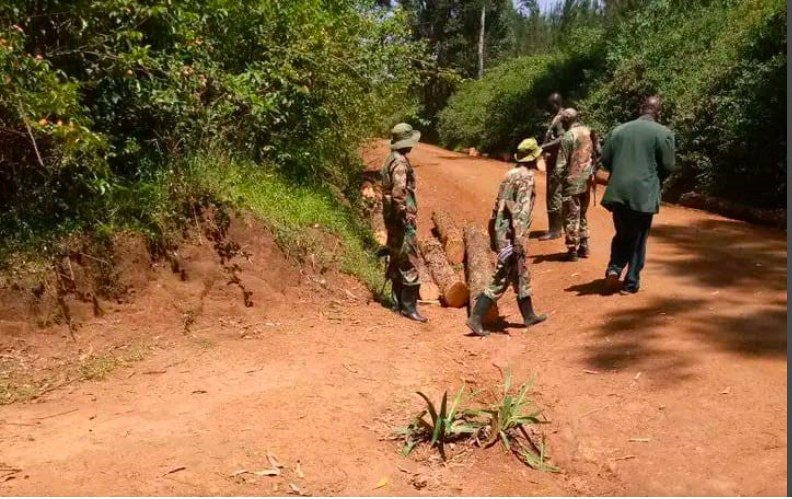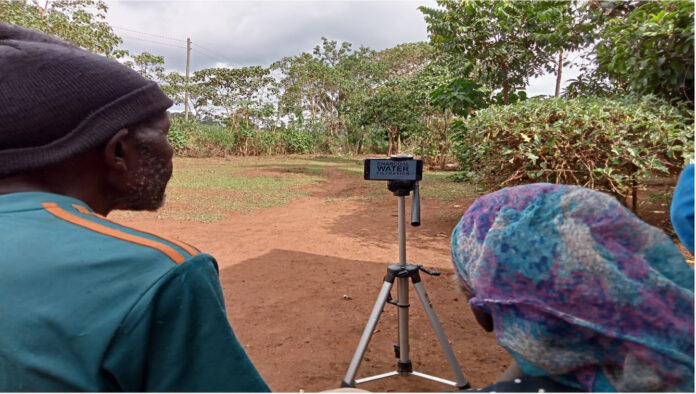By Gabriel Ingubu
Lugari, Kenya: The Charcoal Water Filtration video by Scientific Animation Without Borders (SAWBO) could be the most shared video among Lugari forest community members. The forest sits on 2,163 hectares of land and is surrounded by communities organized into seven groups forming a human fence to keep an eye on any destroyer.
Besides wood and other benefits from trees, the communities also draw water from two points located a few kilometers away from the forest. Furthermore, there is a program by the forest management and the locals to allocate small pieces of land for farming of low cover crops as they support tree growing.
Since my interest was on conservation agriculture, I chose to visit a few in that ring for mapping. Our five hour walk culminated at the same water point for easy exit. At this time, I found a young lad in a blue top drawing water.
“What is it for?” I asked.
“It’s for both human and animal use, this water point never dries up however long it takes without rain,” replied Kibo.
The green water color was a complete turn off to me. I went home thinking of how best the community can access clean water either by getting chlorine at the water point or at their homes.

Sunday 27th March 2022 is the day I checked through the SAWBO library to find out if there are any videos on water filtration. Mid-morning was the time I arrived in this forest community. On my arrival, I find 15 adults, among them is inspector of the forest police waiting for me at a water point which serves as a landmark.
After a brief introduction, Mr. Antony Kibo, (Who I was directed to by the chairman of community Forest Association, Francis Iseru, to guide me through my adventures) took the lead in showing me the all the groups projects in the forest.
Saturday 2nd April 2022 was my day to watch, discuss and put in practice the downloading of selected SAWBO videos. I had prepared for us to watch the Deep tillage and smarter manure use video. At about 11am, I arrived and found members working on nursery beds few meters from the water point. No sooner had I arrived than a lady called the working members for tea break.
All were welcome. I took advantage of the sitting to take the members through the video as we took our tea with buns under a shade of trees. To the shock of the century, when one member requested for more tea, I saw the lady go back to the water point, drew water with a yellow 20 liter modified container and used it to prepare more tea.
“Is this the same water that was used to prepare the tea we are still taking?” I asked in great anguish.
“Yes it is,” the lady responded in broad smile.
At this point few members could realize that I was frustrated. Imaginations of waterborne diseases ranging from typhoid, cholera and many others crisscrossed my mind. I tried to raise my mask to cover my nose and lowered my cap to hide from the reality but my conscience judged me.
“Why did I not give it a priority?” I silently asked myself why not the SAWBO animation on charcoal water filtration, but the deep tillage and smarter manure video?
Although I was satisfied that we had seen the deep tillage video well, my head still hung low on my return journey as the picture of the water point with green water, two logs across and a yellow drawing container kept haunting me.
On 15th April, I returned to the group to show them how to filter water using charcoal with few members of Lumama village, we gathered at Mr. Kibo’s house. We watched the SAWBO video, then we started practicing what we had watched. I had asked Kibo to find sand and charcoal. Global Youth Groove, one of SAWBO’s knowledge partners, provided taps and bucket for the demo. In an exercise that took about 45 minutes, we were able to filter water. We took the experiment to a water point to also show passersby.
During the dry season, this water point supports close to 2800 households from two villages.
“Many of us who use this water add cleaning chemicals but for me, I find it difficult because of the smell of the chemical. I am buying this idea straight away,” Said Angela Khayesi, one of the 30 neighbors who came to watch the experiment.
I went to this village and found a problem. I wanted to do something about the dirty water and the use of charcoal technique came to my mind. The solution was delivered from the SAWBO library and it proved real impact in the community.
Disclaimer
The information and content in the video (content) should not substitute for professional or medical advise of any kind. Purdue University, and SAWBO disclaims responsibility or liability for loss or injury that may be incurred as a result of the use of any content included in the video.














